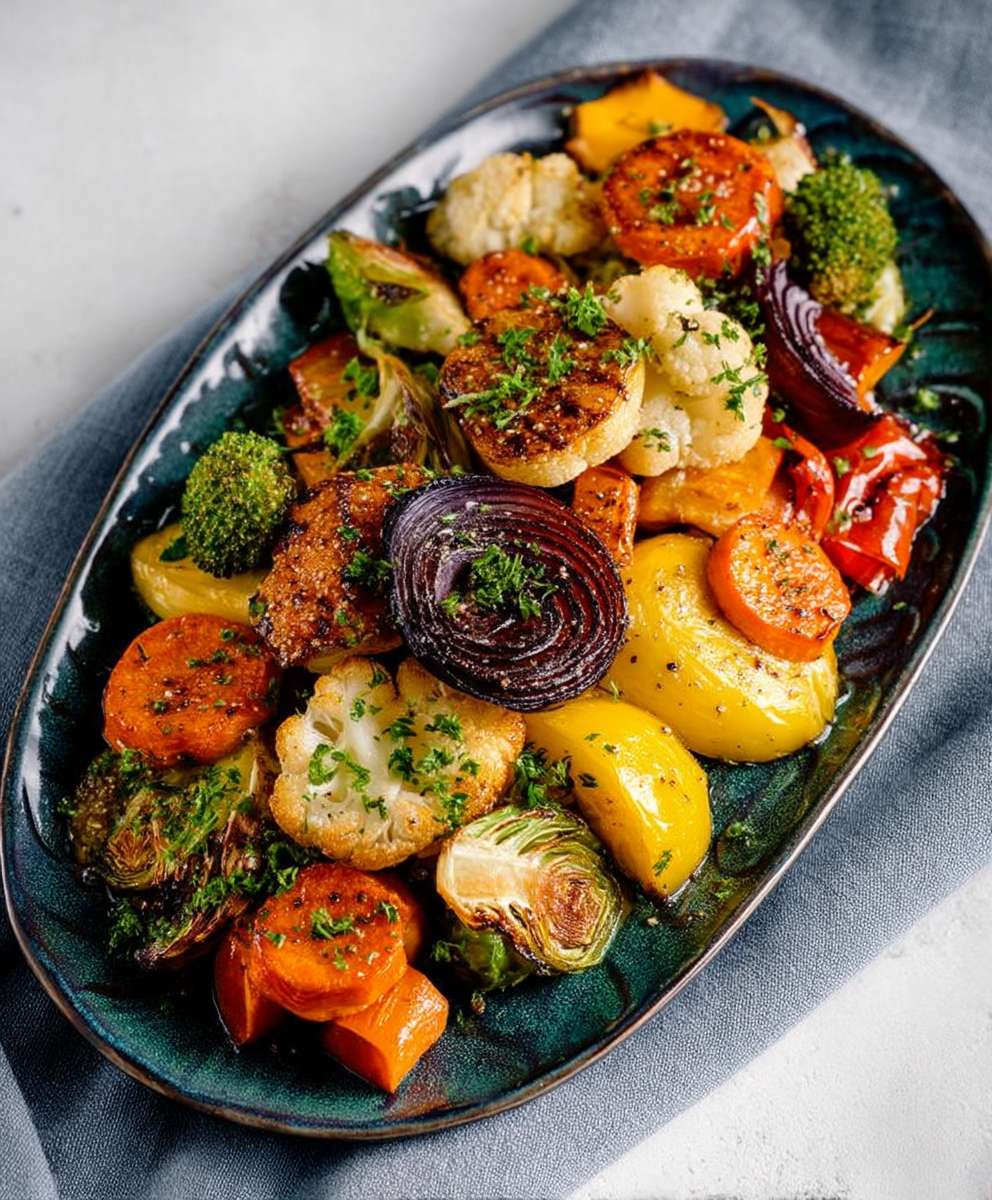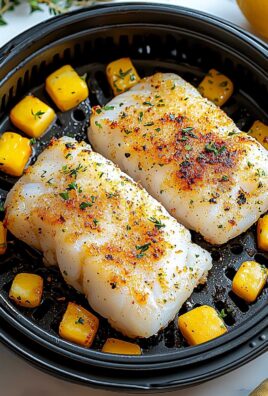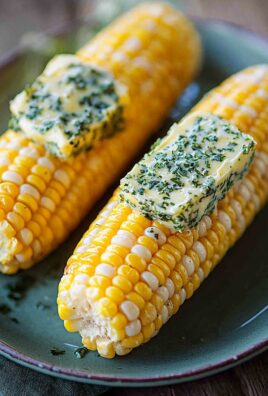Roasted Vegetables: Is there anything more satisfying than a pan bursting with vibrant, caramelized vegetables, their natural sweetness intensified by the heat of the oven? I think not! This simple yet elegant dish has been a staple in kitchens for generations, evolving from a humble way to preserve the harvest to a culinary delight enjoyed worldwide.
The beauty of roasted vegetables lies in their versatility. While the concept is straightforward toss vegetables in oil, season, and roast the possibilities are endless. Think about it: from the earthy sweetness of root vegetables like carrots and parsnips to the vibrant colors of bell peppers and zucchini, each vegetable brings its unique flavor and texture to the party. Roasting coaxes out their natural sugars, creating a depth of flavor that’s simply irresistible.
But why do people love roasted vegetables so much? Beyond the incredible taste, they’re incredibly convenient. A quick chop, a drizzle of oil, and a sprinkle of herbs are all it takes to create a healthy and delicious side dish that complements almost any main course. Plus, they’re a fantastic way to use up leftover vegetables, reducing food waste and saving you money. So, are you ready to discover (or rediscover) the magic of perfectly roasted vegetables? Let’s get started!

Ingredients:
- 1 large red onion, cut into wedges
- 2 bell peppers (1 red, 1 yellow), seeded and cut into 1-inch pieces
- 2 zucchini, cut into 1-inch pieces
- 2 yellow squash, cut into 1-inch pieces
- 1 pound Brussels sprouts, trimmed and halved (or quartered if large)
- 1 pint cherry tomatoes
- 4 carrots, peeled and cut into 1-inch pieces
- 4 cloves garlic, minced
- 1/2 cup olive oil
- 2 tablespoons balsamic vinegar
- 1 tablespoon dried Italian herbs (or a mix of rosemary, thyme, and oregano)
- 1 teaspoon salt
- 1/2 teaspoon black pepper
- 1/4 teaspoon red pepper flakes (optional, for a little heat)
- Fresh parsley, chopped (for garnish)
- Grated Parmesan cheese (optional, for serving)
Preparing the Vegetables:
- Preheat your oven to 400°F (200°C). Making sure your oven is properly preheated is crucial for even roasting. A cold oven will steam the vegetables instead of roasting them, resulting in a soggy texture.
- Wash and dry all the vegetables thoroughly. Excess moisture will hinder the roasting process and prevent the vegetables from browning properly. Use a salad spinner or pat them dry with paper towels.
- Prepare the vegetables according to the ingredient list. Cut the red onion into wedges, bell peppers into 1-inch pieces, zucchini and yellow squash into 1-inch pieces, Brussels sprouts in half (or quarters if large), and carrots into 1-inch pieces. Leave the cherry tomatoes whole. Mince the garlic. Consistent sizing is important for even cooking.
- In a large bowl, combine all the prepared vegetables. Using a large bowl ensures that you have enough room to toss the vegetables without making a mess.
Seasoning and Coating:
- Drizzle the olive oil over the vegetables. Make sure all the vegetables are coated evenly with the oil. Olive oil helps the vegetables to brown and caramelize, enhancing their flavor.
- Add the minced garlic, balsamic vinegar, dried Italian herbs, salt, pepper, and red pepper flakes (if using) to the bowl. The balsamic vinegar adds a touch of sweetness and acidity that complements the roasted vegetables perfectly.
- Toss the vegetables thoroughly to ensure they are evenly coated with the oil and seasonings. Use your hands or a large spoon to toss the vegetables gently but thoroughly. You want to make sure every piece is coated.
Roasting the Vegetables:
- Spread the vegetables in a single layer on a large baking sheet. Avoid overcrowding the baking sheet, as this will cause the vegetables to steam instead of roast. If necessary, use two baking sheets.
- Roast in the preheated oven for 30-40 minutes, or until the vegetables are tender and slightly browned. The roasting time will vary depending on the size and density of the vegetables.
- Halfway through the roasting time (after about 20 minutes), toss the vegetables to ensure even cooking. This will help them to brown evenly on all sides.
- Continue roasting until the vegetables are tender and slightly caramelized. You can test for doneness by piercing a carrot or Brussels sprout with a fork. It should be easily pierced with minimal resistance.
- If you want the vegetables to be more browned, you can broil them for the last few minutes of cooking. Keep a close eye on them to prevent burning. Broiling can quickly add a nice char to the vegetables.
Serving and Garnishing:
- Remove the roasted vegetables from the oven and let them cool slightly. Allowing them to cool slightly will prevent them from being too hot to handle.
- Transfer the roasted vegetables to a serving dish. Choose a serving dish that is appropriate for the amount of vegetables you have prepared.
- Garnish with fresh chopped parsley. Fresh parsley adds a pop of color and freshness to the dish.
- Optional: Sprinkle with grated Parmesan cheese before serving. Parmesan cheese adds a salty and savory flavor that complements the roasted vegetables.
- Serve immediately. Roasted vegetables are best served warm or at room temperature.
Tips and Variations:
- Add other vegetables: Feel free to add other vegetables to the mix, such as sweet potatoes, butternut squash, asparagus, or broccoli. Adjust the roasting time accordingly.
- Use different herbs and spices: Experiment with different herbs and spices to create your own unique flavor combinations. Try using rosemary, thyme, oregano, garlic powder, onion powder, or smoked paprika.
- Add a squeeze of lemon juice: A squeeze of fresh lemon juice after roasting can brighten up the flavors of the vegetables.
- Roast with sausage or chicken: Add sausage or chicken to the baking sheet for a complete meal. Make sure to adjust the roasting time accordingly.
- Make a sheet pan dinner: Combine the roasted vegetables with cooked grains, such as quinoa or rice, for a healthy and satisfying sheet pan dinner.
- Store leftovers: Leftover roasted vegetables can be stored in an airtight container in the refrigerator for up to 3 days. Reheat them in the oven or microwave before serving.
- For crispier vegetables: Ensure the vegetables are very dry before roasting. You can also toss them with a tablespoon of cornstarch before adding the oil and seasonings. This will help absorb any excess moisture and promote browning.
- Don’t overcrowd the pan: This is worth repeating! Overcrowding leads to steaming, not roasting. Use two pans if necessary.
- High heat is key: Roasting at a higher temperature (400°F or 200°C) helps to caramelize the vegetables and develop their flavor.
- Consider the density of the vegetables: Denser vegetables like carrots and potatoes will take longer to cook than softer vegetables like zucchini and bell peppers. You may need to add the denser vegetables to the oven a few minutes before the softer ones.
- Add a touch of sweetness: A drizzle of maple syrup or honey after roasting can add a touch of sweetness that complements the savory flavors of the vegetables.
- Spice it up: For a spicier dish, add a pinch of cayenne pepper or a dash of hot sauce to the vegetables before roasting.
- Make it a salad: Toss the roasted vegetables with mixed greens, a vinaigrette dressing, and some crumbled cheese for a delicious and healthy salad.
- Serve as a side dish: Roasted vegetables are a versatile side dish that pairs well with a variety of main courses, such as grilled chicken, steak, or fish.
- Use a roasting rack: Placing the vegetables on a roasting rack inside the baking sheet can help to promote even browning and prevent them from sticking to the pan.
- Pre-cook dense vegetables: If you’re using very dense vegetables like potatoes or sweet potatoes, you can pre-cook them in the microwave for a few minutes before roasting to shorten the overall cooking time.
- Add some nuts: Toasted nuts, such as almonds, walnuts, or pecans, can add a crunchy texture and nutty flavor to the roasted vegetables.
- Use a parchment paper or silicone mat: Lining the baking sheet with parchment paper or a silicone mat can prevent the vegetables from sticking and make cleanup easier.
- Don’t be afraid to experiment: The best way to find your favorite roasted vegetable combination is to experiment with different vegetables, herbs, and spices.

Conclusion:
And there you have it! This Roasted Vegetables recipe isn’t just another side dish; it’s a flavor explosion waiting to happen. I truly believe this is a must-try for anyone looking to elevate their weeknight dinners or impress guests with minimal effort. The beauty of this recipe lies in its simplicity and adaptability. The natural sweetness of the vegetables intensifies as they roast, creating a symphony of flavors that’s both comforting and exciting.
Why is this a must-try? Because it’s incredibly versatile! You can use almost any vegetable you have on hand, making it a fantastic way to use up those odds and ends in your fridge. Plus, it’s a healthy and delicious way to get your daily dose of veggies. The slight char on the edges adds a delightful smoky note that complements the inherent sweetness of the vegetables. It’s a dish that appeals to both picky eaters and seasoned foodies alike.
But the fun doesn’t stop there! Let’s talk serving suggestions and variations. These roasted vegetables are fantastic as a side dish alongside grilled chicken, fish, or steak. They’re also amazing tossed with pasta and a sprinkle of Parmesan cheese for a quick and easy vegetarian meal. For a heartier dish, try adding some cooked sausage or chickpeas to the roasting pan.
Looking for some variation ideas? Consider adding a drizzle of balsamic glaze after roasting for a touch of sweetness and acidity. A sprinkle of fresh herbs like rosemary, thyme, or oregano can also elevate the flavor profile. For a spicier kick, add a pinch of red pepper flakes to the vegetables before roasting. You could even experiment with different types of oil, such as avocado oil or coconut oil, to add a unique flavor dimension.
Another fantastic way to enjoy these roasted vegetables is in a salad. Let them cool slightly and then toss them with mixed greens, crumbled feta cheese, and a light vinaigrette. They also make a delicious addition to grain bowls, adding both flavor and texture. I’ve even used them as a topping for pizza! The possibilities are truly endless.
I’m confident that once you try this recipe, it will become a staple in your kitchen. It’s a simple, healthy, and delicious way to enjoy the bounty of fresh vegetables. The key is to experiment with different combinations of vegetables and seasonings to find your perfect blend. Don’t be afraid to get creative and have fun with it!
So, what are you waiting for? Grab your favorite vegetables, preheat your oven, and get roasting! I’m so excited for you to try this recipe and experience the deliciousness for yourself.
And now, for the most important part: I want to hear from you! Once you’ve made this Roasted Vegetables recipe, please share your experience in the comments below. What vegetables did you use? What variations did you try? Did you love it as much as I do? Your feedback is invaluable, and I can’t wait to see your culinary creations. Happy roasting!
Roasted Vegetables: The Ultimate Guide to Perfecting Your Roast
A vibrant and flavorful medley of roasted vegetables, tossed with olive oil, balsamic vinegar, and Italian herbs. Perfect as a side dish or a healthy meal.
Ingredients
- 1 large red onion, cut into wedges
- 2 bell peppers (1 red, 1 yellow), seeded and cut into 1-inch pieces
- 2 zucchini, cut into 1-inch pieces
- 2 yellow squash, cut into 1-inch pieces
- 1 pound Brussels sprouts, trimmed and halved (or quartered if large)
- 1 pint cherry tomatoes
- 4 carrots, peeled and cut into 1-inch pieces
- 4 cloves garlic, minced
- 1/2 cup olive oil
- 2 tablespoons balsamic vinegar
- 1 tablespoon dried Italian herbs (or a mix of rosemary, thyme, and oregano)
- 1 teaspoon salt
- 1/2 teaspoon black pepper
- 1/4 teaspoon red pepper flakes (optional, for a little heat)
- Fresh parsley, chopped (for garnish)
- Grated Parmesan cheese (optional, for serving)
Instructions
- Preheat: Preheat your oven to 400°F (200°C).
- Wash & Dry: Wash and dry all the vegetables thoroughly.
- Prepare: Cut the red onion into wedges, bell peppers into 1-inch pieces, zucchini and yellow squash into 1-inch pieces, Brussels sprouts in half (or quarters if large), and carrots into 1-inch pieces. Leave the cherry tomatoes whole. Mince the garlic.
- Combine: In a large bowl, combine all the prepared vegetables.
- Drizzle: Drizzle the olive oil over the vegetables.
- Season: Add the minced garlic, balsamic vinegar, dried Italian herbs, salt, pepper, and red pepper flakes (if using) to the bowl.
- Toss: Toss the vegetables thoroughly to ensure they are evenly coated with the oil and seasonings.
- Spread: Spread the vegetables in a single layer on a large baking sheet. Avoid overcrowding.
- Roast: Roast in the preheated oven for 30-40 minutes, or until the vegetables are tender and slightly browned.
- Toss Halfway: Halfway through the roasting time (after about 20 minutes), toss the vegetables to ensure even cooking.
- Cool Slightly: Remove the roasted vegetables from the oven and let them cool slightly.
- Transfer: Transfer the roasted vegetables to a serving dish.
- Garnish: Garnish with fresh chopped parsley.
- Optional: Sprinkle with grated Parmesan cheese before serving.
- Serve: Serve immediately.
Notes
- Add other vegetables: Feel free to add other vegetables to the mix, such as sweet potatoes, butternut squash, asparagus, or broccoli. Adjust the roasting time accordingly.
- Use different herbs and spices: Experiment with different herbs and spices to create your own unique flavor combinations. Try using rosemary, thyme, oregano, garlic powder, onion powder, or smoked paprika.
- Add a squeeze of lemon juice: A squeeze of fresh lemon juice after roasting can brighten up the flavors of the vegetables.
- Roast with sausage or chicken: Add sausage or chicken to the baking sheet for a complete meal. Make sure to adjust the roasting time accordingly.
- Make a sheet pan dinner: Combine the roasted vegetables with cooked grains, such as quinoa or rice, for a healthy and satisfying sheet pan dinner.
- Store leftovers: Leftover roasted vegetables can be stored in an airtight container in the refrigerator for up to 3 days. Reheat them in the oven or microwave before serving.
- For crispier vegetables: Ensure the vegetables are very dry before roasting. You can also toss them with a tablespoon of cornstarch before adding the oil and seasonings. This will help absorb any excess moisture and promote browning.
- Don’t overcrowd the pan: This is worth repeating! Overcrowding leads to steaming, not roasting. Use two pans if necessary.
- High heat is key: Roasting at a higher temperature (400°F or 200°C) helps to caramelize the vegetables and develop their flavor.
- Consider the density of the vegetables: Denser vegetables like carrots and potatoes will take longer to cook than softer vegetables like zucchini and bell peppers. You may need to add the denser vegetables to the oven a few minutes before the softer ones.
- Add a touch of sweetness: A drizzle of maple syrup or honey after roasting can add a touch of sweetness that complements the savory flavors of the vegetables.
- Spice it up: For a spicier dish, add a pinch of cayenne pepper or a dash of hot sauce to the vegetables before roasting.
- Make it a salad: Toss the roasted vegetables with mixed greens, a vinaigrette dressing, and some crumbled cheese for a delicious and healthy salad.
- Serve as a side dish: Roasted vegetables are a versatile side dish that pairs well with a variety of main courses, such as grilled chicken, steak, or fish.
- Use a roasting rack: Placing the vegetables on a roasting rack inside the baking sheet can help to promote even browning and prevent them from sticking to the pan.
- Pre-cook dense vegetables: If you’re using very dense vegetables like potatoes or sweet potatoes, you can pre-cook them in the microwave for a few minutes before roasting to shorten the overall cooking time.
- Add some nuts: Toasted nuts, such as almonds, walnuts, or pecans, can add a crunchy texture and nutty flavor to the roasted vegetables.
- Use a parchment paper or silicone mat: Lining the baking sheet with parchment paper or a silicone mat can prevent the vegetables from sticking and make cleanup easier.
- Don’t be afraid to experiment: The best way to find your favorite roasted vegetable combination is to experiment with different vegetables, herbs, and spices.




Leave a Comment